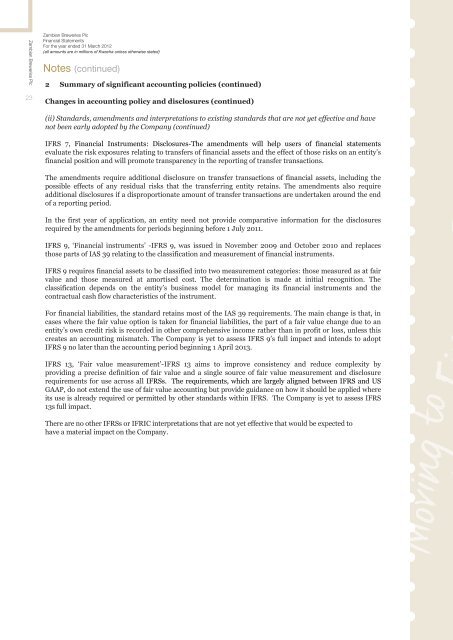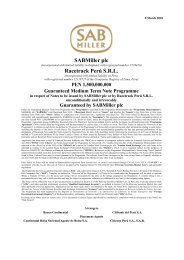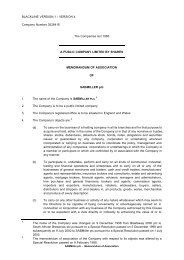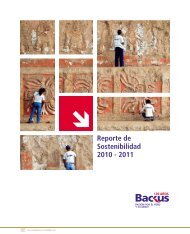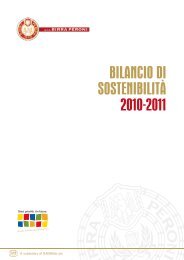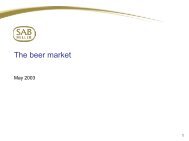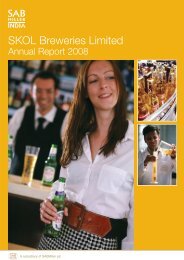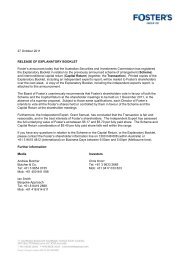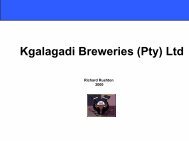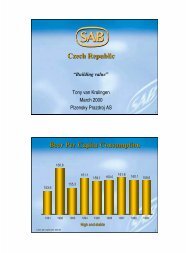Zambian Breweries Annual Report - Released June 2012 - SABMiller
Zambian Breweries Annual Report - Released June 2012 - SABMiller
Zambian Breweries Annual Report - Released June 2012 - SABMiller
Create successful ePaper yourself
Turn your PDF publications into a flip-book with our unique Google optimized e-Paper software.
<strong>Zambian</strong> <strong>Breweries</strong> Plc<br />
<strong>Zambian</strong> <strong>Breweries</strong> Plc<br />
Financial Statements<br />
For the year ended 31 March <strong>2012</strong><br />
(all amounts are in millions of Kwacha unless otherwise stated)<br />
Notes (continued)<br />
2 Summary of significant accounting policies (continued)<br />
23<br />
Changes in accounting policy and disclosures (continued)<br />
(ii) Standards, amendments and interpretations to existing standards that are not yet effective and have<br />
not been early adopted by the Company (continued)<br />
IFRS 7, Financial Instruments: Disclosures-The amendments will help users of financial statements<br />
evaluate the risk exposures relating to transfers of financial assets and the effect of those risks on an entity’s<br />
financial position and will promote transparency in the reporting of transfer transactions.<br />
The amendments require additional disclosure on transfer transactions of financial assets, including the<br />
possible effects of any residual risks that the transferring entity retains. The amendments also require<br />
additional disclosures if a disproportionate amount of transfer transactions are undertaken around the end<br />
of a reporting period.<br />
In the first year of application, an entity need not provide comparative information for the disclosures<br />
required by the amendments for periods beginning before 1 July 2011.<br />
IFRS 9, ‘Financial instruments’ -IFRS 9, was issued in November 2009 and October 2010 and replaces<br />
those parts of IAS 39 relating to the classification and measurement of financial instruments.<br />
IFRS 9 requires financial assets to be classified into two measurement categories: those measured as at fair<br />
value and those measured at amortised cost. The determination is made at initial recognition. The<br />
classification depends on the entity’s business model for managing its financial instruments and the<br />
contractual cash flow characteristics of the instrument.<br />
For financial liabilities, the standard retains most of the IAS 39 requirements. The main change is that, in<br />
cases where the fair value option is taken for financial liabilities, the part of a fair value change due to an<br />
entity’s own credit risk is recorded in other comprehensive income rather than in profit or loss, unless this<br />
creates an accounting mismatch. The Company is yet to assess IFRS 9’s full impact and intends to adopt<br />
IFRS 9 no later than the accounting period beginning 1 April 2013.<br />
IFRS 13, ‘Fair value measurement’-IFRS 13 aims to improve consistency and reduce complexity by<br />
providing a precise definition of fair value and a single source of fair value measurement and disclosure<br />
requirements for use across all IFRSs. The requirements, which are largely aligned between IFRS and US<br />
GAAP, do not extend the use of fair value accounting but provide guidance on how it should be applied where<br />
its use is already required or permitted by other standards within IFRS. The Company is yet to assess IFRS<br />
13s full impact.<br />
There are no other IFRSs or IFRIC interpretations that are not yet effective that would be expected to<br />
have a material impact on the Company.<br />
12


